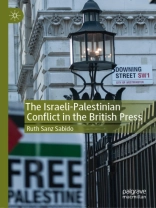The Israeli-Palestinian Conflict in the British Press provides an extensive empirical analysis of how the Israeli-Palestinian conflict has been constructed in British national newspapers since 1948. It traces the evolution of representations of the conflict by placing them in a historical context, with particular reference to Britain’s postcolonial relation to Palestine, and by presenting an in-depth analysis of the evolution of press language, including the use of terms such as ‘terrorism’ and ‘terrorist’ to classify agents of political violence. It applies an original approach to the study of media coverage, using a Postcolonial Critical Discourse Analysis framework, an innovative method that examines selected case studies in relation to theories of postcolonialism and discourse. Using this unique hybrid methodology, Sanz Sabido provides a thorough and precise unpicking of a highly mediated conflict.
Inhoudsopgave
Chapter 1: Introduction: The Promised Land and a Land of Promises .-Chapter 2: Postcolonial Critical Discourse Analysis: Theory and Method.-Chapter 3: Contextualising the conflict: A Brief History of the Land.-Chapter 4: Contextualising the Israeli-Palestinian conflict in the news .-Chapter 5: Situating political violence: ‘Terrorism’ and discourse.-Chapter 6: ‘Terrorism’ and the Israeli-Palestinian conflict in the news .-Chapter 7: Identity, Conflict and Visibility.-Chapter 8: Conclusions.
Over de auteur
Ruth Sanz Sabido is Reader in Media and Social Inequality at Canterbury Christ Church University, UK. She is the author of
Memories of the Spanish Civil War: Conflict and Community in Rural Spain (2016), and has edited or co-edited several collections, including
Representing Communities: Discourse and Contexts (2017),
Sites of Protest (2016) and
Contemporary Protest and the Legacy of Dissent (2014).












